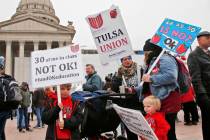Multicultural marketing is the name of the game
From its simplistic Sin City image just a couple of decades ago, Las Vegas has transformed into a global city where millions of migrants settle and numerous new businesses set up shop every year.
The result is a local population that is one of the most diverse in the country. Add the thousands of tourists who fly or drive into and out of the city borders on a regular basis, Las Vegas is now one of the most international cities in the United States.
Because of this increasing diversity, the need for multicultural marketing, including public relations and advertising, is becoming increasingly important.
“Multicultural PR and advertising is the practice of targeting ethnic consumers and other niche consumer groups using culturally appropriate best practices of public relations, marketing and advertising,” Corin Ramos of Walson Communications said.
Walson Communications, where Ramos is a principal member, is a multicultural public relations, advertising and social media marketing agency “that specializes in aligning companies with ethnic audiences in Las Vegas in a culturally appropriate and dynamic style.”
The firm, primarily “makes multicultural media and communications an integral part of the larger marketing strategy,” Ramos said. “That’s really what we do. No need to reinvent the wheel, just add another spoke.”
“It’s very important to me that companies respect our cultures and communities with culturally appropriate messages,” Ramos said.
The firm targets local immigrant groups such as the Hispanic and black communities. But its core competency is reaching out to Asian-Americans and Pacific Islanders.
Ramos noted that Walson focuses on this niche because it is the fastest-growing group in the state. Indeed, at an explosive 116.5 percent growth, the population increase of Asian-Americans and Pacific Islanders in Nevada from 2000-2010 is exceptional.
Figures from the U.S. Census Bureau show that this community has greatly outpaced the growth of the state’s Hispanic population. The latter group, which for decades was the fastest growing group in Nevada, grew by a slower 81.9 percent in the same period.
“AAPIs (Asian-Americans and Pacific Islanders) make up over 10 percent of the U.S. population, and nearly 8 percent of Nevada. If at least 10 percent of your company’s marketing and advertising budget isn’t going towards this population, then you are missing out on a very viable consumer market,” Ramos said.
The public relations professional also emphasized habits of Asian-American consumers by quoting a recent Nielsen report that shows the group’s current buying power has increased a huge 523 percent since 1990.
The nationwide 2012 study, titled “State of the Asian-American Consumer,” stated, “Asian-American buying power, currently at $718 billion, is estimated to reach $1 trillion by 2017.”
Ramos noted that Nielsen’s findings are true to Asian-Americans and Pacific Islanders in Las Vegas as well, particularly about food shopping. “One of our most distinguishing factors as a consumer is our food shopping behavior. We like fresh foods, fish and meats. We love rice,” she said.
“Try to find parking in Chinatown on a weekend. Ever see an Albertsons or Vons as packed as a 99 Ranch or Seafood City on a Saturday?” she asked.
But even as shopping habits are more or less common among different Asian-American communities in the United States, the group itself is very diverse, making marketing a challenge.
“While the Asian-American and Pacific Islander communities do have many commonalities, we are also very distinct and we have separate cultures. Learn and respect those differences,” Ramos said.
“The most common mistake companies make is assuming a one-size-fits-all approach when it comes to communicating with AAPI groups,” she said, noting that a campaign or message to one Asian ethnic group will not work just as well for another.
She cited an example early in her career. “We helped (a client) become a sponsor at an exhibit during Tet Festival or Vietnamese Lunar New Year celebration, the biggest Tet celebration in the U.S. When I told them we needed to make a banner for their booth with some Vietnamese words on it, they brought out a banner they had used at a recent Korean festival with some Korean words on it.”
“(They) asked me, (if it) will do. Needless to say, I earned my first month’s retainer with a simple no,” she said.
Multicultural marketing firm in multiethnic Las Vegas
Clients are just half of what Ramos thinks about whenever she creates campaigns or formulates public relations strategies. It has been her life-long advocacy to be a voice of the Asian-American community to which she belongs.
“My firm focuses on helping companies reach AAPI audiences, not only because of my experiences as an Asian-American, but also to ensure that our voices and our stories are included in all aspects of American life and society,” she said.
To let everyone know “how viable and important my community is to American society as a whole” is her main goal.
Ramos came to the U.S. from the Philippines when she was only 5 years old. “I grew up Westernized, but my parents also instilled strong cultural pride in me and my sister,” she said.
“My dad always said to take the best from both worlds, and I feel that my upbringing has given me a big advantage as well as a responsibility to be a bridge between those two worlds,” she added.
After college, Ramos’ advocacy led her to write for several ethnic newspapers in California. She eventually made the transition to public relations and began a fruitful career in the field. One of her most notable positions was director of public relations and marketing for nonprofit National Fibromyalgia Association. But Ramos said that a budding passion to start her own business and her inherent advocacy to champion fellow Asian-Americans resulted in the birth of Walson Communications in 2006.
“I’ve always had that entrepreneurial blood in me. It runs in my family. I also wanted to do more work with multicultural campaigns. So, I decided to go out on my own with Walson Communications,” she said. “Walson was my married name at the time.”
The firm prides itself in being a full-service multicultural public relations and social media marketing agency.
The Walson team assists clients in advertising by securing broadcast and print media to tell a story that will reach audiences. They will also negotiate for the best rates. In addition, the team will also help in picking the most effective ethnic media publication “that will be most effective for clients’ advertising dollars.”
For its public relations services, Walson clients can expect to tap not only into the company’s extensive list of key national and local ethnic media contacts, but also businesses and community groups relevant to the target audiences.
Media professionals at Walson Communications will also create press kits for dissemination, write news releases for print media and produce broadcast announcements for television, radio or Web.
Event planning is also another area where the Walson team can assist its clients. In fact, the firm will play the lead role as liaison between the client and vendors. The firm vows to negotiate with vendors for the best rates and services. It can also help find the most dynamic speakers for events, as well as the right companies who will want to be sponsors of the event.
Walson’s talented team of graphic designers, meanwhile, will also design and produce materials — such as event flyers, badges, binders, hand outs — for the events. Needless to say, the design team will know how to create culturally appropriate designs that “will resonate and appeal” to either a specific ethnic audience or a client’s multiethnic target market. After each event, the Walson team will also do post-event follow-ups including thanking speakers, sponsors and attendees, noting on its website, “You want them to come back again, don’t you?”
Social and other skills needed in multicultural marketing
But a guaranteed way of making any audience come back is the constant presence of a client in social media, which is part of the overall public relations strategy of Walson Communications.
In its website, the firm stated that it “performs proven public relations tactics, including publicizing an event using the latest social media tools.” These include Facebook, Twitter and LinkedIn. The online presence of a client in these sites, among others, is also closely monitored.
Social media is the future of the public relations and marketing profession, Ramos said. She recalled, “In 2008, Facebook was still new and few organizations recognized how powerful it could be as a vehicle for their messages.”
“(But) I spent 90 percent of my time on social media then and was able to do great things for our clients from the ground floor of their social media communications campaigns,” she said.
An extensive knowledge of social media tools is what Ramos would recommend to those who plan to enter multicultural public relations and marketing. Marketing via social media is one of the most effective ways to reach Asian-American audiences, she noted.
Indeed, the 2012 Nielsen study showed that “Asian-Americans visit computer and consumer electronics websites 36 percent more often, spend 72 percent more time and visit 84 percent more pages than the total population.”
“Asian-Americans spend an average of 80 hours surfing the Internet each month. They view 3,600 Web pages monthly, which is 1,000 pages higher than any other demographic group,” the study also noted.
“We are more likely to share, like or purchase a product after seeing an ad on a social network,” Ramos observed.
The Nielsen study, however, clarified that the numbers reported are based on the English-speaking segments of the Asian-American community.
There is still a segment of this community that relies on in-language media as its primary source of information and entertainment. Ignoring this viable segment could prove to be a costly mistake for businesses, Ramos said.
“Ethnic audiences are very loyal readers and viewers and loyal consumers to the advertisers who support their media outlets,” she observed.
“There are over 800 traditional AAPI media outlets in the U.S. and they are thriving despite the economic implosion that general media have experienced,” she added.
Familiarity with the habits of all segments of the Asian-American community is an important part of multicultural marketing.
“Learning even a little bit about each group’s traditions, customs, food, dress, language, media are good places to start,” Ramos said, noting this can be as easy as attending events of the different Asian-American and Pacific Islander businesses and social organizations.
“It’s not as hard or intimidating as it may sound. It’s actually a lot of fun,” she said.
Although Walson Communications offers its proven professional expertise in multicultural marketing, Ramos said it can be beneficial for Las Vegas firms to hire full-time employees who will focus on reaching out to Asian-Americans.
“Definitely, especially the hospitality industry here in Las Vegas. I do know that one of the two biggest casino companies here already have a multicultural marketing department and staff members who focus specifically on Asian marketing,” she said.
If a company is not that large but it still wants to reach out to Asian-American consumers, it does not need to develop a one-time campaign or separate multicultural marketing group, Ramos said.
“Instead, make (the Asian-American market) part of your larger marketing strategy. Be inclusive. Reach out to their community media, join the ethnic chambers of commerce and attend events hosted by AAPI community organizations,” she said.
“Or, be prepared to lose out on the opportunity to reach the fastest growing consumer market and ethnic population in the U.S.,” she added.









